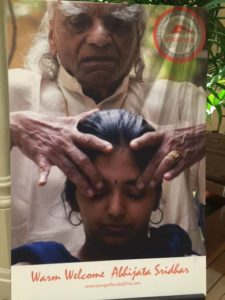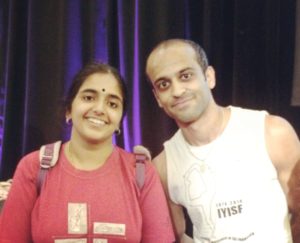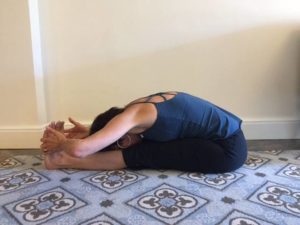 Reflecting upon my experience at this 2016 Iyengar Convention, this theme of periphery to the core to the periphery and so on resonates on many levels. I have often felt slightly on the periphery when teachers describe studies in Pune and with the Iyengars. This initial study with Abhijata Sridhar Iyengar felt then akin to peeling away these outermost layers ripe with feelings of alienation and distance as with each passing day at the convention, I felt welcomed into and wholeheartedly drawn into intimate ‘being’ – the core of this practice and lineage. Abhijata’s warm greeting with hands high up by her forehead in namaskarasana symbolizes her deep respect for the individual soul on this journey as well as her courage in meeting, greeting and calling forward each one. I was one of over 1,100 and yet, her message and her en’courage’ment was deeply personal. Before our practice sessions, senior teachers spoke to all of us of personal reflections on and moments shared with Guruji. While Abhijata’s teachings brought me immediately towards my core each session – ‘be quiet’, ‘go inside’, those individual sharings brought
Reflecting upon my experience at this 2016 Iyengar Convention, this theme of periphery to the core to the periphery and so on resonates on many levels. I have often felt slightly on the periphery when teachers describe studies in Pune and with the Iyengars. This initial study with Abhijata Sridhar Iyengar felt then akin to peeling away these outermost layers ripe with feelings of alienation and distance as with each passing day at the convention, I felt welcomed into and wholeheartedly drawn into intimate ‘being’ – the core of this practice and lineage. Abhijata’s warm greeting with hands high up by her forehead in namaskarasana symbolizes her deep respect for the individual soul on this journey as well as her courage in meeting, greeting and calling forward each one. I was one of over 1,100 and yet, her message and her en’courage’ment was deeply personal. Before our practice sessions, senior teachers spoke to all of us of personal reflections on and moments shared with Guruji. While Abhijata’s teachings brought me immediately towards my core each session – ‘be quiet’, ‘go inside’, those individual sharings brought
meperiphery to the core to the periphery, grateful. Today, I am joyfully unfolding and remembering eachcloser to the heart and soul, the core of this man BKS Iyengar. For both experiences, I am, from the
story, each lesson learned, when I practice. Inspiration for reaching inside to my  core to share back to the periphery which inevitable contacts the core and so on. Namaste. – Rebecca Haralabatos
core to share back to the periphery which inevitable contacts the core and so on. Namaste. – Rebecca Haralabatos
A couple things really sunk in for me during Abhijata’s teaching. I liked when she reminded us that we should treat every instruction as if we had never heard it before, because maybe we hadn’t got to the core of it. And I liked the observation, both in Geetaji’s recorded comments and Abhijata’s teaching, that at every level of penetration and understanding, there is a periphery and a core. This especially came home to me in trying to be sensitive to the skin, to the outward facing and the inward facing side of our skin, to the skin as the boundary, the periphery, but also as having a side that is more core than periphery, to times when we draw the skin onto the body for support and strength, and times when we bring the inner body towards the skin, also for support and strength. It was interesting how much that kind of detailed attention to the skin brought the mind to a quiet, inward place. – Michael Lucey
 I ruminated on the convention’s theme, periphery to the core to the periphery, throughout the five days we were together as a national community experiencing Abhijata’s profound teachings, many of us her students for the first time. I think about Abhijata, a young mother raised in the Iyengar family in the core of it all. Abhijata talks about knowing her grandfather and, at the age of 17, thinks she wants to learn about ‘this’ yoga and why people around the world are drawn to it and her grandfather in particular. She remained though on the periphery until after she earned a master’s degree when she then returned to the core as her grandfather’s yoga student, to remain under his intense guidance for the past 14 years. I often hear of successful professionals who let their degrees and occupations go for the study of yoga. Each time, I am surprised and not so surprised. With Guruji’s passing, she has come out of that core and graces us with her teachings and knowledge. I am in awe of her ability and confidence, her loving eyes a fierce reminder of the transformative possibilities of this intense practice. As Guruji told her, there are no excuses. Most of us are at the periphery of our experience in yoga study, yet we catch repeated glimpses into the core. This oscillation from periphery to core is how we can gradually dip into and identify with this vast subject and endless expanse of knowledge; how we gradually grow in our willingness to simply be. Be with yourself. Be with your breath. Be with your mind. Be with your body. Be with your soul. They are all connected. Like her grandfather, Abhijata is a clear example of complete commitment to being with yoga, within her core and with the periphery, her students throughout the world. Om. Namaste. – Anneke Faas
I ruminated on the convention’s theme, periphery to the core to the periphery, throughout the five days we were together as a national community experiencing Abhijata’s profound teachings, many of us her students for the first time. I think about Abhijata, a young mother raised in the Iyengar family in the core of it all. Abhijata talks about knowing her grandfather and, at the age of 17, thinks she wants to learn about ‘this’ yoga and why people around the world are drawn to it and her grandfather in particular. She remained though on the periphery until after she earned a master’s degree when she then returned to the core as her grandfather’s yoga student, to remain under his intense guidance for the past 14 years. I often hear of successful professionals who let their degrees and occupations go for the study of yoga. Each time, I am surprised and not so surprised. With Guruji’s passing, she has come out of that core and graces us with her teachings and knowledge. I am in awe of her ability and confidence, her loving eyes a fierce reminder of the transformative possibilities of this intense practice. As Guruji told her, there are no excuses. Most of us are at the periphery of our experience in yoga study, yet we catch repeated glimpses into the core. This oscillation from periphery to core is how we can gradually dip into and identify with this vast subject and endless expanse of knowledge; how we gradually grow in our willingness to simply be. Be with yourself. Be with your breath. Be with your mind. Be with your body. Be with your soul. They are all connected. Like her grandfather, Abhijata is a clear example of complete commitment to being with yoga, within her core and with the periphery, her students throughout the world. Om. Namaste. – Anneke Faas
 When I heard Guruji’s grandaughter Abhijata would act as the convention in Boca Raton’s lead teacher, I reflected on the time I spent at RIMYI in 2008. At that point Abhijata had already spent 10 years studying with Guruji, Geeta, her aunt, and Pranshant, her uncle. During an asana demonstration as part of the Guru Purnima celebration, Abhijata’s mastery of the poses were evident along with her devotion to yoga and her gratitude to her grandfather. However, although Abhijata clearly had the knowledge to teach well, she had not fully come into her own as a teacher. I found her shy and somewhat tentative. Fast forward 8 years to the convention, the contrast is startling. The scope of her knowledge, the clarity and depth of her instructions, her passionate, lively style all captivated me, and I would venture to say, most, if not, all of the other 1,100 participants as well. Although she is unmistakably a member of the Iyengar family, Abhijata has a voice and an approach to teaching that is all her own. I am happy to report that our yoga lineage is in very capable hands. – Sarah Harvey
When I heard Guruji’s grandaughter Abhijata would act as the convention in Boca Raton’s lead teacher, I reflected on the time I spent at RIMYI in 2008. At that point Abhijata had already spent 10 years studying with Guruji, Geeta, her aunt, and Pranshant, her uncle. During an asana demonstration as part of the Guru Purnima celebration, Abhijata’s mastery of the poses were evident along with her devotion to yoga and her gratitude to her grandfather. However, although Abhijata clearly had the knowledge to teach well, she had not fully come into her own as a teacher. I found her shy and somewhat tentative. Fast forward 8 years to the convention, the contrast is startling. The scope of her knowledge, the clarity and depth of her instructions, her passionate, lively style all captivated me, and I would venture to say, most, if not, all of the other 1,100 participants as well. Although she is unmistakably a member of the Iyengar family, Abhijata has a voice and an approach to teaching that is all her own. I am happy to report that our yoga lineage is in very capable hands. – Sarah Harvey

The Iyengar 2016 convention in Boca Raton was an absolutely amazing experience—a milestone in my yoga sadhana. I felt deep gratitude for Abhijata’s time, devotion, and teachings, and I was fully absorbed during the practice. There were moments I was unaware of the thousand plus yogis gathered in the same large ballroom around me. One day when lucky enough to practice directly below center stage, I remember making eye contact with Abhijata through the parivrtta (revolved) asana practice. We did so many deep twists, I felt like a sponge in marichyasana III and parivritta parsvakonasana. At one point, I looked back at Abhi in parivrtta paschimottanasana, a new pose in my regular practice, and felt as though she was teaching directly, personally to me yet in fact, she was teaching directly to 1,100 of us at the same time! We ranged from beginning to intermediate students, menstruating students, pregnant students, injured students, certified teachers and advance senior teachers practicing all at once. Abhijata took us from her core to our periphery to our core to her periphery and back again! An amazing gift handed down to her by Guruji BKS Iyengar.
 Throughout the conference, I was overwhelmed by the love and support I received from the Iyengar community via my Facebook videos and Instagram posts. All the exchanges and updates, the lunches and dinners, the beaches and photos. It was all so inspiring. I will continue to prescribe this theme of periphery to the core, core to the periphery in my personal and interpersonal life. It may not be a new theme to some of us, but it is a powerful mantra to guide oneself in a dual world of purusha and prakriti, of yin and yang, of darkness and lightness —as above, so below, as within, so without—of abhyasa (practice) and vairagya (non-attachment) taking place at once. To be in the core and around the periphery all at once – Zain Syed
Throughout the conference, I was overwhelmed by the love and support I received from the Iyengar community via my Facebook videos and Instagram posts. All the exchanges and updates, the lunches and dinners, the beaches and photos. It was all so inspiring. I will continue to prescribe this theme of periphery to the core, core to the periphery in my personal and interpersonal life. It may not be a new theme to some of us, but it is a powerful mantra to guide oneself in a dual world of purusha and prakriti, of yin and yang, of darkness and lightness —as above, so below, as within, so without—of abhyasa (practice) and vairagya (non-attachment) taking place at once. To be in the core and around the periphery all at once – Zain Syed
 “Do you know why we pay so much attention to detail?” BKS Iyengar asked Abijata this question many years ago. When she didn’t know the answer, he asked her to consider whether the face was more important than the small toe. And he went on to explain that the practice of yoga is about awakening every cell in the body. To ignore the small toe, is to miss something amazing. Stand in Tadasana and bring your attention to your small toes. Try to lift them; it’s not as easy as lifting the big toes. But notice the effect on the legs and the inner thighs and the outer hips when you even attempt to lift the small toes. And notice the stability and life that comes to the entire leg! Who would want to miss this experience?!? This is the essence of Iyengar Yoga.
“Do you know why we pay so much attention to detail?” BKS Iyengar asked Abijata this question many years ago. When she didn’t know the answer, he asked her to consider whether the face was more important than the small toe. And he went on to explain that the practice of yoga is about awakening every cell in the body. To ignore the small toe, is to miss something amazing. Stand in Tadasana and bring your attention to your small toes. Try to lift them; it’s not as easy as lifting the big toes. But notice the effect on the legs and the inner thighs and the outer hips when you even attempt to lift the small toes. And notice the stability and life that comes to the entire leg! Who would want to miss this experience?!? This is the essence of Iyengar Yoga.
 And then on Day 3… Abhijata’s teaching continues to get deeper and richer. Those who were lucky enough to have studied with Guruji report that she is channelling him well. One of my favorite gems from the day went something like this: Reaching the head to the legs is not the point of Pachimottanasana. Asana is not some end-point that we are supposed to reach. Asana is a means to an end; a means to understand the mind. In that way, asana is like a prop that helps us understand the mind. – Theresa Marks
And then on Day 3… Abhijata’s teaching continues to get deeper and richer. Those who were lucky enough to have studied with Guruji report that she is channelling him well. One of my favorite gems from the day went something like this: Reaching the head to the legs is not the point of Pachimottanasana. Asana is not some end-point that we are supposed to reach. Asana is a means to an end; a means to understand the mind. In that way, asana is like a prop that helps us understand the mind. – Theresa Marks
During the convention, Abhijata made what Manouso Manos likes to call a “throw away statement” (something you easily miss if you not paying attention), a comment which has become a touchstone for my practices since. We were practicing Utthita Parsvakonasana when she told someone to ‘look up’, ‘looking down belongs to the brooding mind’. I immediately realized I was also looking down. When I looked up – I felt not only how it extended my frontal body, but how it opened my mind. Since I tend to be a brooder, I’ve since realized how often I look down when I’m concentrating. There is a quality of introversion, of shutting out the world when I look down and in. But, there is a point when we have to look up – to trust our internal experience and show up in the world. If you want to see how this expresses in your own body, try for a moment standing in Tadasana. Without letting the chest fall, let your eyes gaze slightly downward as you adjust in the pose. Then, bring the eyes horizontal Observe your internal response to the movement of the eyes. Enjoy. – Melinda Morey
In a recent article in Yoga Samachar, Siegfried Behler, an Iyengar yoga teacher from West Virginia, explored Patanjali’s yoga sutras, particularly the concept of Samadhi and its relation to experiential,  quantitative/ qualitative, subjective/objective, subtle/gross knowledge. Fascinated with the article, when I spotted Siegfried at the convention I asked him how the experience of Samadhi differs from Samyama? The third pada (chapter) of the sutras defines Samyama as the junction of the last three limbs of the ashtanga “ladder.” Since Samadhi is the uppermost rung of the ladder and highest state of total absorption and dissolution of subject/object relationship, how could the addition of Dharana and Dhyana (the sixth and seventh limbs, concentration and meditation respectively) to Samadhi in any way add to or improve upon that state? How would they differ, and can we even comprehend that difference, without having experienced these states? After a bit of discussion and thought, in a beautiful glass-ceilinged atrium in Boca Raton, Siegfried reflected that Samyama leads us to the siddhis, the mystical yogic powers. Possession of a siddhi would empower you, for example, such that if real life pulled you out of your meditative state, you were then able to go right back to taking care of your kids without losing equanimity, without emotional reactivity. So the eight limbs of yoga, which take us on an inward quest from the periphery to the core, culminate in Samyama and, thus integrated, stay present within us when we journey back towards our periphery–this time in that higher vibrational state which is the gift of this yoga practice. On a more personal level, I felt the convention brought me closer to Guruji BKS Iyengar, in the stories we heard, the way his teachings were constantly evoked, and the connection to him through his granddaughter Abhijata. I feel as if I just spent four days in his presence, and that he is truly present with us. – Nina Carson
quantitative/ qualitative, subjective/objective, subtle/gross knowledge. Fascinated with the article, when I spotted Siegfried at the convention I asked him how the experience of Samadhi differs from Samyama? The third pada (chapter) of the sutras defines Samyama as the junction of the last three limbs of the ashtanga “ladder.” Since Samadhi is the uppermost rung of the ladder and highest state of total absorption and dissolution of subject/object relationship, how could the addition of Dharana and Dhyana (the sixth and seventh limbs, concentration and meditation respectively) to Samadhi in any way add to or improve upon that state? How would they differ, and can we even comprehend that difference, without having experienced these states? After a bit of discussion and thought, in a beautiful glass-ceilinged atrium in Boca Raton, Siegfried reflected that Samyama leads us to the siddhis, the mystical yogic powers. Possession of a siddhi would empower you, for example, such that if real life pulled you out of your meditative state, you were then able to go right back to taking care of your kids without losing equanimity, without emotional reactivity. So the eight limbs of yoga, which take us on an inward quest from the periphery to the core, culminate in Samyama and, thus integrated, stay present within us when we journey back towards our periphery–this time in that higher vibrational state which is the gift of this yoga practice. On a more personal level, I felt the convention brought me closer to Guruji BKS Iyengar, in the stories we heard, the way his teachings were constantly evoked, and the connection to him through his granddaughter Abhijata. I feel as if I just spent four days in his presence, and that he is truly present with us. – Nina Carson


Christine Corsa says
Lovely memories of an amazing experience…..expressed beautifully!!! Thanks for sharing!